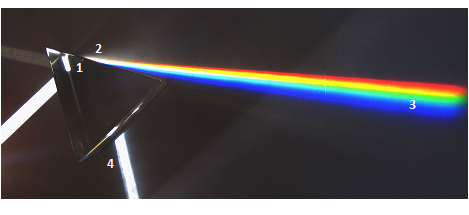
THE TAO OF COLOURS
by Doug Marsh

Part 1 : The Dynamic Interplay of Light and Darkness
It’s all cut and dried – literally; science teaches us that light can be split into component colours. Such a lifeless and desiccated concept of nature leaves colours as nothing more than meaningless “objective” wavelengths that impinge upon our eyes. The human soul and spirit don’t factor in at all.
Holistic science, on the other hand, takes an alternative view of colours that fully embraces life and the dynamics of nature, consistent with the ancient principles of Lao Tzu in the Tao Te Ching. The mysterious Tao truly manifests in colour phenomena.
Physics Entity Crisis
What should be regarded as a force [light] is understood in a material sense, while what is an impeded, moderated force is thought to be disintegrated, crushed, dissipated.
J.W. von Goethe
Non-being, to name the origin of heaven and earth;
Being, to name the mother of ten thousand things.
Therefore, by the Everlasting Non-Being,
We desire to observe its hidden mystery;
By the Everlasting Being,
We desire to observe the manifestations.
Lao Tzu
Ever since the advent of quantum theory several decades ago, the science of physics has undergone an intense re-evaluation of its worldview, a struggle that continues to reverberate to this day. Rather than an identity crisis such as people may experience, you could say physics has been suffering an entity crisis, particularly with the nature of light. For centuries, physicists have been chasing after the mystery of light, confident that they would one day unveil its innermost secrets. The chase has been based on an underlying assumption and belief that light is an entity – a material object at the sub-sensible level. This presumed entity has proven to be extremely elusive prey.
Pioneers of the current scientific method were originally convinced that light consisted of small particles, or corpuscles, that impinged upon the eyes to give us the sensation of sight. The particle theory eventually fell by the wayside when light was found to behave more like a wave. The wave concept prospered and was very much the rage for some time, until its certitude encountered sudden turbulence. Quantum theory began to determine a strange wave-particle duality attribute of light; at one moment it could behave simultaneously as both a wave and a particle. The photon, the hypothetical elementary unit of light, also displayed other bizarre and ambiguous attributes in experiments. Quantum physicist Arthur Zajonc compared light’s paradoxical characteristics to finding a physical object in our sense world that had no particular mass, colour, shape, size or position!
The study of light has essentially headed into a maze, and physics has been unable to find its way out. Stephen Edelglass, scientific researcher and educator, suggests that the original path taken was a wrong turn – that the bizarre outcomes of light in quantum theory point to faulty thinking at the outset. We simply cannot imagine light as an elementary entity that’s like an “object” or a “thing” we encounter in our everyday sense experience. Although such abstract concepts based on analogies may serve a practical purpose for prediction and control in the service of industry and technology, they become untenable in the attempt to understand the ultimate nature of light.
It’s curious that heat, a close relative of light, had earlier undergone a somewhat similar entity crisis of its own, but science ultimately took a different direction when faced with ambiguity. Galileo had originally conceived of heat as “a multitude of minute particles having certain shapes and moving with certain velocities. Meeting with our bodies they penetrate by means of their extreme subtlety, and their touch as felt by us when they pass through our substance is the sensation we call ‘heat’.” In the eighteenth century, heat was hypothesized as a physical substance termed caloric that flowed like a liquid. Chemist Antoine Lavoisier found that, under certain situations, caloric would have no weight, or even negative weight. These findings seemed to nullify the idea of heat as a substance. Instead, heat is now theorized by science as simply a measurable property (temperature) of energy transfer from one body to another.
Matter, the most sacred principle of all in classical physics, has also been undergoing an entity crisis. The electron – the subatomic charged particle building block of matter – apparently displays the paradoxical wave-particle duality. Then there’s the conundrum of the Heisenberg Uncertainty Principle which states “the more precisely the position [of an electron] is determined, the less precisely the momentum is known in this instant, and vice versa.” The notion of more exact measurement is thus a Catch-22; the very process of measurement at the subatomic level actually changes the entity being measured to accurately define it. As Lao Tzu stated, “The farther you go, the less you know.”
Are all these entity crises indicative of a threshold condition in physics? Have physicists hit the border that separates the physical from the metaphysical? Perhaps the bizarre and paradoxical findings point more to the immaterial realm of Taoist “Non-Being” than the material realm of “Being.” Conventional science continually skirts around the dicey issue, considering the immaterial territory to be non-reality. Perhaps science needs to take a more all-encompassing approach that bridges the ponderable and imponderable by embracing qualitative and affective aspects of reality. An holistic science provides such an approach, observing the “hidden mystery” (light) by its “manifestations” (colours).
Holistic Colour Science
Ever splitting the light! How often do they strive to divide that which, despite everything, would always remain single and whole.
J.W. von Goethe
Once the whole is divided, the parts need names.
There are already enough names.
One must know when to stop.
Lao Tzu
Analytical science – what is commonly referred to as garden variety science – takes the whole, then dices, slices, counts and mathematizes with tremendous zeal. There’s no disputing the fruits of this type of scientific endeavour in developed nations. Ever since the industrial revolution, science has been touted as a panacea against the struggle to survive and opened the door to greater prosperity. Not until recent times has there been the widespread recognition that this sort of science is a double edged sword; it’s cut a mark in many other ways. Many are now well aware of the threats to our health, our ecology and our economy imposed by our dependence on the rampant spread of technology.
Sir Isaac Newton used analytical science to supposedly prove how colours are contained within the original light. We are taught that he discovered his findings by means of his famous experiment with the prism, splitting the light into the uniform spectrum. Yet his experimentation was more like an illusionist’s trick; the rainbow of colours that emerged through the prism was conjured like the transformation of a white silk handkerchief into other colours. Henri Bortoft, a physicist and philosopher of science, refers to such a science conclusion as “sleight of mind.” The idea of spectral colours being separated from the light is an inversion of the thought process. The idea wasn’t discovered from the experiment; rather, the so-called objective experiment was actually a demonstration of Newton’s preconceived idea (theory). The entity bias – the corpuscular particles – was built in from the start.
Sir Arthur Eddington, astrophysicist and philosopher of science, spoke of Newton’s prism experiment in a discussion of “Discovery or Manufacture?” Eddington compared it to a sculptor who theorizes that a human head exists within a rough block of marble. The sculptor proceeds with his experiment, and after chipping away with the chisel, proves his theory with the presentation of a human bust. In Newton’s case, the prism unwittingly served as both the block and the chisel that manufactured the end result that he “saw” there all along.
Although Newton wasn’t out to intentionally manufacture trickery, another big name in the history of science apparently had no such qualms. Although René Descartes is known for his legacy of the mind-body Cartesian split, he could well be considered a forerunner to the modern illusionist entertainment industry. When studying how a rainbow appears in the sky, Descartes devised a scheme to create an artificial rainbow. He wished to create “an invention for making [religious] signs appear in the sky, which would cause great wonder in those who were ignorant of the causes… But I admit that skill and much work would be necessary in order to proportion these fountains, and to cause the liquids there to leap so high that these figures could be seen from afar by a whole nation, without the trick being discovered.” (Does this tale perhaps suggest a partial parallel to the state of current analytical science – an elitist undertaking to control the “ignorant” masses?)
An alternative to analytical science is holistic science, an approach to nature which doesn’t divide the whole. It’s a qualitative study of nature that embraces unity and strives to continually identify relationships. Phenomena may be classified in an analytical sense, but are not cut off and treated as separate entities. Everything remains connected and interdependent. Not a subjective science as it is sometimes wrongly labelled, holistic science actually unites the artificial Cartesian split of objectivity and subjectivity; it’s a participatory science where the role of the human is front and centre – the heart and soul of the inquiry.
Johann Wolfgang von Goethe, the renowned German poet, novelist and playwright, dedicated much of his life studying phenomena in the tradition of natural philosophy. His scientific endeavours encompassed wide-ranging research in subjects such as geology, meteorology, botany, morphology, and colour. Rudolf Steiner, who was formally educated in the classical sciences, edited Goethe’s major scientific writings, bringing his works to a broader audience. The impact of Goethe’s holistic science of phenomenology has been so great that it is termed Goethean Science. Steiner took Goethean Science to a new level when he founded his Anthroposophy.
Of all Goethe’s scientific works, his voluminous study of colour has probably drawn the most attention – unfortunately, not for the reasons Goethe had hoped. His writing on colour was partly a stinging polemic against the dominant Newtonian science of the era which he found to be so dehumanizing. Not surprisingly, his battle met with strong resistance from classical, analytical science. Goethe wasn’t trained as a physicist or mathematician, so his observations on colour phenomena were soundly rejected by the majority of analytical scientists, and still are to this day. Most of the criticism, though, amounts to superficial comments from those entrenched in dogmatic scientism.
The entity crisis in physics has seen somewhat of a revival of Goethean colour science. A few quantum physicists and analytical scientists have broken free from dogma and, having studied Goethe’s work in depth, appreciate the merits of this holistic science. Werner Heisenberg even went on record as saying, “If one should wish to reproach Goethe, it could only be for not going far enough - that is, for having attacked the views of Newton instead of declaring that the whole of Newtonian Physics-Optics, Mechanics and the Law of Gravitation - were from the devil.” Zajonc, a contemporary expert on Goethean Science, suggests that Goethe’s “gentle empiricism” offers an antidote to science’s “black void of pure instrumentalism” and its looming “demoralizing nihilism.”
Goethe’s intense, participatory study of colour phenomena led him to see a dynamic interplay of the forces of light and darkness. It’s a polarity that is consistent with Taoist principles.
The Polarity of Colour Phenomena
Light and darkness united dynamically by means of turbidity generate colour.
J.W. von Goethe
Therefore being and non-being give rise to each other,
The difficult and easy complement each other,
The long and short shape each other,
Voices and instruments harmonize with one another,
The front and rear follow upon each other.
Lao Tzu
Imagine you’re in a soundproof room with a viewing window beside a wind tunnel and are unable to tell if the air is rushing by. Then a wind chime is placed in the tunnel and a speaker is turned on. Suddenly you see the chimes moving and you hear the tinkling tones. The force of air had to interact with physical objects before you were aware of its presence. A material medium was needed for reference.
Zajonc once built a special demonstration box as a science exhibit for viewing pure light. The box was carefully constructed so that it didn’t illuminate any interior surfaces. When the projector light was turned on and shone intensely inside the box, all one could see was utter, deep darkness. The light itself was invisible. Attached to the box was a handle connected to a wand that could penetrate into the exhibit. Once inside, the wand brightly lit up.
A common misconception is that pure light is white. A sunbeam through a window in a room during the day, or the beams spreading from a car’s headlights at night, are due to the light interacting with a surface or fine air particles. An example of pure light without geometric “rays” or “beams” is a full moon on a clear night. The sun’s reflection gives us the light by the silvery moon, but nowhere can rays of pure light from the sun be seen in the night sky.
I liken this aspect of pure light somewhat to pure consciousness. Consciousness is perhaps beyond the temporal and spatial in another realm or dimension – not localized in the brain – and cannot be directly detected by the external senses. When consciousness interacts with brain matter, suddenly ideas, images and sounds “appear,” seemingly out of nowhere.
Goethe intently studied the coloured fringes that appear through a prism. He concluded that the condition of the famous ROY G BIV spectral colours of the rainbow that alight is but a special, isolated case. A few examples of coloured fringes as viewed through a prism are shown in Figures 1 to 4. Figure 5 shows how coloured fringes actually emerge from a prism contrasted against an erroneous educational depiction.
Goethe eventually abandoned the prism as a complicating factor and began to observe the phenomena outdoors in the sky and the landscape to find the core conditions where colours first emerge. Like axioms in geometry, he sought to discover situations which form the basis for all other colour phenomena. He eventually narrowed it down to two such primal phenomena:
Light emitted through a colourless, transparent medium first manifests as white. As the medium becomes denser and the transparency decreases, the light darkens to hues of yellow, orange, and red. The sun takes on these hues depending on whether it’s overhead or near the horizon where the atmosphere is thicker. At the extreme end of densification and opacity, light is shut out to black.
Darkness illuminated through a colourless, transparent medium first manifests as black. As the medium becomes denser and the transparency decreases, the darkness lightens to hues of violet, indigo, and blue. The black night sky becomes modified by the sun’s daytime illumination and displays a range of these hues, from dark blue overhead to light blue near the horizon. At the extreme end of densification and opacity, darkness is diminished to whiteness.
What’s key to these two phenomena is the dynamic interplay of light and darkness. The darkening of light in the one case, and the lightening of darkness in the second case, create opposite ranges of colours. Because of this, Goethe suggested the term polarity was most suited to colour phenomena, for it represents “the eternal systole and diastole, the eternal collapsion and expansion, the inspiration and expiration of the world in which we live and move.”
Colour bands occur through a prism due to a mingling of these polar forces. Reviewing Figures 1 to 5(b), you can see how these phenomena arise along edges between light and dark. As a band of light or dark becomes narrowed, the primal colours unite to form secondary colours of green or magenta.
A prism isn’t the only condition for the polar opposite coloured bands to appear. In the seventeenth century, Francesco Maria Grimaldi, a mathematician and physicist, studied coloured fringes that developed when a very narrow beam of sunlight was projected along the edges of small objects. He noted that the shadows cast were “always bluish at the side which is nearer the [central] shadow and reddish on the further side.” Polar colour effects can be seen when looking at a light through a feather or reflected from a compact disc (See Figure 6). The media may differ, but a similar dynamic and complex interaction occurs between the light and the darkness.
Goethe also studied the relationship between colour perception and the eye, and found the eye to be very responsive in the process. The motto, “For every action, there’s an equal and opposite reaction,” certainly applies, as the eye responds to outer colours with inner complementary colours. Goethe developed a colour circle to represent the primal colour phenomena and the role of the eye in colour perception (Figure 7). Heinrich Proskauer, an expert in Goethean colour science, noted that Goethe’s colour circle is “a living, holistic figure before us, one that is qualitatively differentiated throughout … each color is always one-sided. Only a union of the opposing pairs can represent the whole and therewith an active totality. This is a reconciliation of the polarities of light and darkness into unity at the highest level.”
Goethe further studied colour from the standpoint of emotions and feelings – considered out-of-bounds territory for analytical colour science. He noted that the yellow-to-red hues are warm colours: “The feelings they excite are quick, lively, aspiring.” On the other pole, the violet-to-blue cool colours “produce a restless, susceptible, anxious impression.” Green, which is a mixture between these extremes, has a more balanced impact, for the beholder “experiences a distinctly grateful impression” and “has neither the wish nor the power to imagine a state beyond it.”
Colour manifestation is, indeed, another example of nature’s polarity at work, well recognized in Taoism and known more commonly nowadays with the concept of Yin/Yang (Figure 8 as seen through a prism). Rather than opposing forces being fixed, absolute and competing, they are flexible, changing and complementary. René Guénon, the French metaphysician, explained that yang (active principle) and yin (passive principle) “are associated symbolically with light and darkness; in all things the light side is yang, the dark side is yin … in the domain of manifestation, yang is never without yin, nor yin without yang.” Darkness, then, isn’t simply the absence of light, but its passive counterpart. These invisible, polar currents don’t simply mix to give what might be considered a two-dimensional grey, but dynamically mingle in such a way that colours seem to spring to life in a third dimension. It’s apt that the prism is a triangular shape, the “Great Triad” of esoteric symbolism, representing the union of complementary polarities.
Analytical science has classified several different technical cases where colours can arise, such as refraction, diffraction, dispersion, scattering, and interference. The scientists then hypothesize beneath what our senses confront to try and find a common microscopic entity or element that is the cause – whether it be a particle, a wave, wave-particle duality, or some other mysterious entity or process not yet dreamed up. The theories and mathematics are impressive, but the knowledge of light and colours studied in this materialistic manner is a disjointed venture that dissects and deadens nature.
For holistic science, whether one calls it refraction or diffraction, it’s all a distraction. Goethe studied the phenomena on their terms at the sense level and had no interest in abstract concepts or theoretical causes added beneath the phenomena. He strove to identify the common conditions where colours arise in nature, and his approach provides coherence, relationships and unity. It truly is in tune with the Tao.
With all the theoretical struggles in physics over the past three centuries, vision science continues to be based mainly on the Newtonian model of optics and colours. The eye is studied as an “object,” artificially disconnected from the human soul and spirit. The industry believed they discovered a physical defect (progressive myopia), where in fact – like the spectrum supposedly split apart by the prism – they actually manufactured the condition and foisted it upon an unsuspecting public. What’s myopic is the old science itself, unable to see where it’s gone astray. A more holistic and Taoist approach to the study of light, colour and human vision is long overdue.
The concluding Part 2 of this article series, Restoring the Spirit of Colour Inquiry, explores in more detail the enigmatic interplay of light and darkness through a prism.
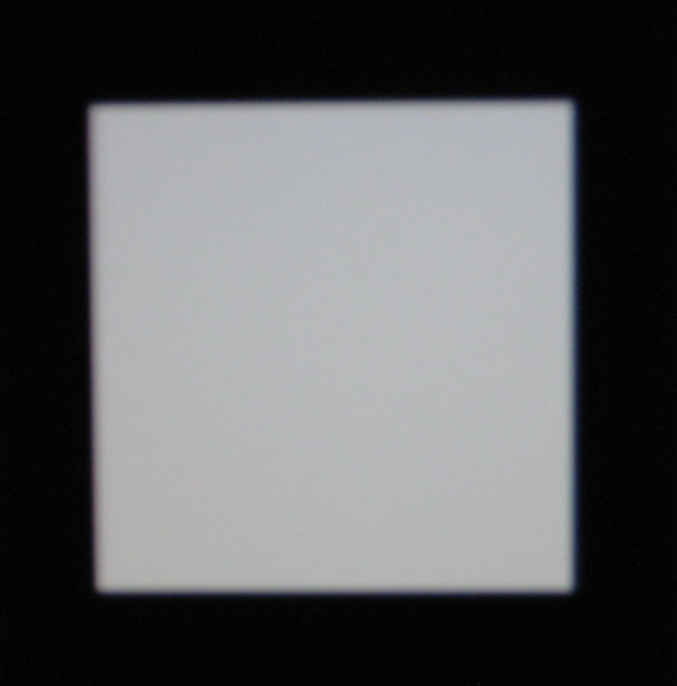
(a) (b)
Figure 1
White rectangle with black background (a) and as seen through prism (b)
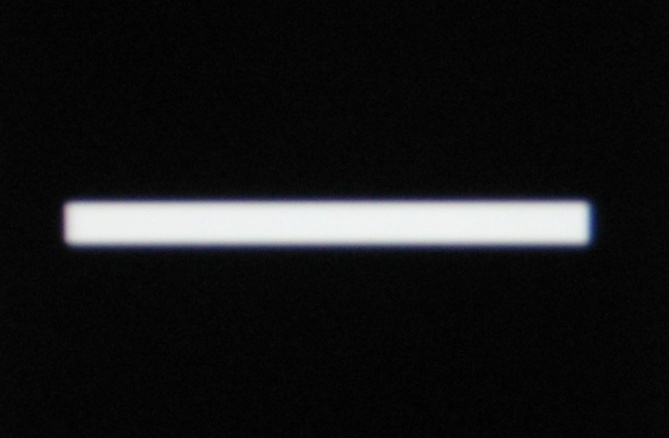
(a) (b)
Figure 2
Narrow white rectangle with black background (a) and as seen through prism (b). Note the appearance of green in the middle once the coloured fringes in Figure 1 merged.
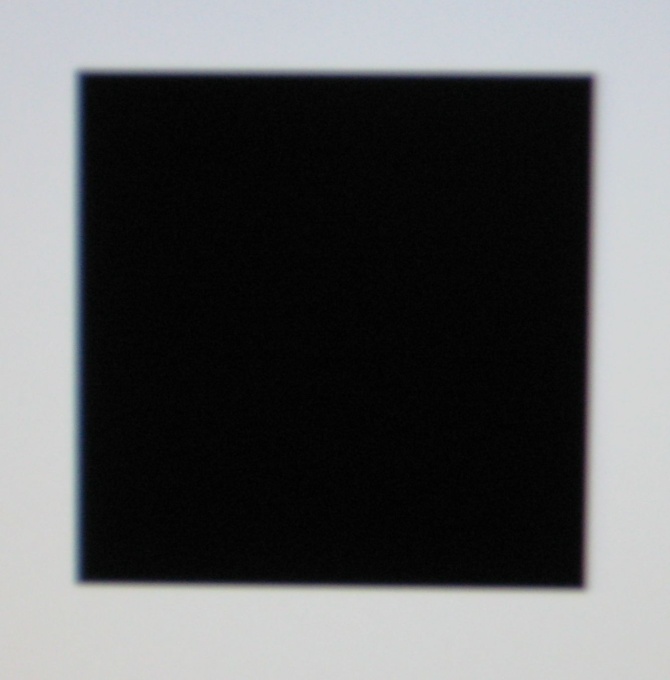
(a) (b)
Figure 3
Black rectangle with white background (a) and as seen through prism (b)
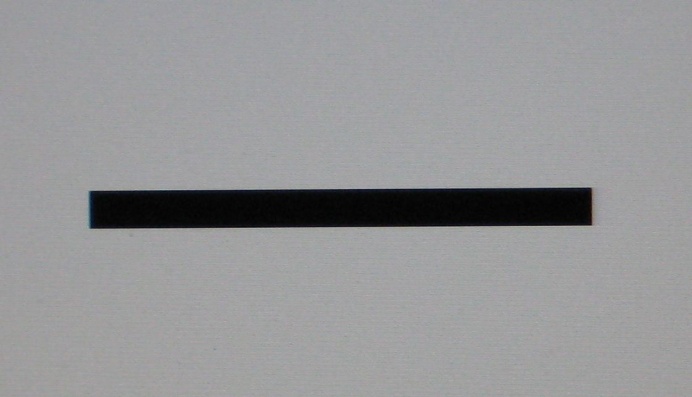
(a) (b)
Figure 4
Narrow black rectangle with white background (a) and as seen through prism (b). Note the appearance of magenta in the middle once the coloured fringes in Figure 3 merged.
(a)
Figure 5
Erroneous educational depiction of how a prism is supposed to “split” light into component “parts” in geometric precision, both within the prism and outside the prism (a).
(b)
Actual light through a prism (b). Note there is no spectrum within the prism (1), nor does it appear immediately out of the prism (2). The band of yellow-to-red and the band of blue-to-violet emerge from the edges, while a beam of white is still visible in the middle. The green colour develops further out when the polar coloured light bands disperse and unite (3). Note also that the reflected portion of the beam within the prism exits at the base (4). No colour spectrum emerges, contrary to what classical Newtonian science claims is supposed happen due to refraction (bending of the beam of light from the glass to the air).
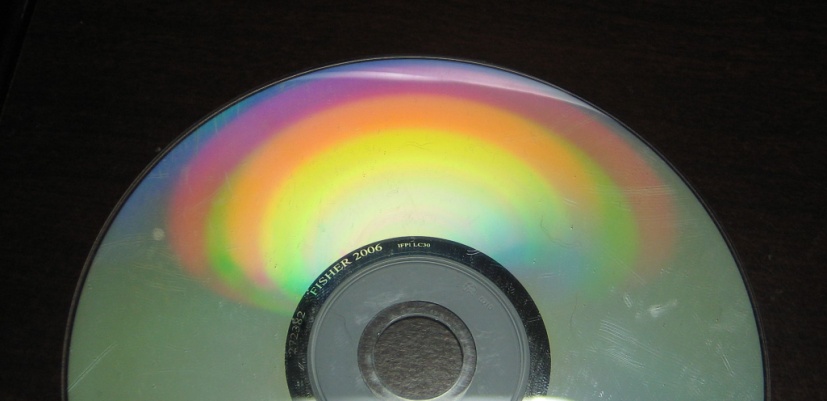
(a) (b)
Figure 6
Dynamic interplay of light and darkness create coloured bands. Light seen through a feather (a) and reflected from a CD (b).
Figure 7
Goethe’s colour circle.
Figure 8
Taoist Yin/Yang symbol as seen through prism.
Part 2
Bibliography
Bortoft, Henri. The Wholeness of Nature: Goethe’s Science Way of Science. Edinburgh, UK: Floris Books, 1996, 2007.
Eddington, Arthur. The Philosophy of Physical Science. Ann Arbor: The University of Michigan Press, 1958.
Edelglass, Stephen, Georg Maier, Hans Gebert, and John Davy. The Marriage of Sense and Thought: Imaginative Participation in Science. Hudson, NY: Lindisfarne Books, 1992.
Goethe, Johann Wolfgang von. Theory of Colours, translated by Charles L. Eastlake. Cambridge: MIT Press, 1970.
Guénon, René. The Great Triad, translated by Henry D. Fohr, edited by Samuel D. Fohr. Hillsdale, NY: Sophia Perennis, 2001.
Lao Tzu. Tao Te Ching. In The “Tao Te Ching:” A New Translation With Commentary, translated by Ellen M. Chen. St. Paul, Minn.: Paragon House, 1989.
Lehrs, Ernst. Man or Matter: Introduction to a Spiritual Understanding of Nature on the Basis of Goethe's Method of Training Observation and Thought. Charleston, SC: BiblioBazaar, 2006.
Pesic, Peter. Sky in a Bottle. Cambridge: MIT Press, 2007.
Proskauer, Heinrich O. The Rediscovery of Color: Goethe versus Newton Today. Spring Valley, NY: Anthroposophic Press, 1986.
Steiner, Rudolf. First Scientific Lecture-Course: The Light Course. Ten Lectures Given in Stuttgart, 23rd December 1919 to 3rd January 1920. Authorized Translation by George Adams M.A. from the 1925 Edition of the Original. Issued by the Natural Scientific Section of the Goetheanum, Dornach, Switzerland. Rudolf Steiner Archive. http://wn.rsarchive.org/Lectures/LightCrse/LitCrs_index.html
______. Science: An Introductory Reader, compiled with an introduction, commentary and notes by Howard Smith. Forest Row, UK: Sophia Books, 2003.
______. Second Scientific Lecture-Course: Warmth Course. Fourteen Lectures, Given in Stuttgart, March 1-14, 1920. Chestnut Ridge, NY: Mercury Press, 1980. http://wn.rsarchive.org/Lectures/WarmthCrse/WrmCrs_index.html
Zajonc, Arthur. Catching the Light: The Entwined History of Light and Mind. New York: Bantam Books, 1993.
Zemplén, Gábor Áron. “An Eye For Optical Theory? Newton’s Rejection of the Modificationist Tradition and Goethe’s Modificationist Critique of Newton.” PhD thesis, Technological University, Budapest, 2001.
Part 2 © Doug Marsh 2010 - 2011
Home